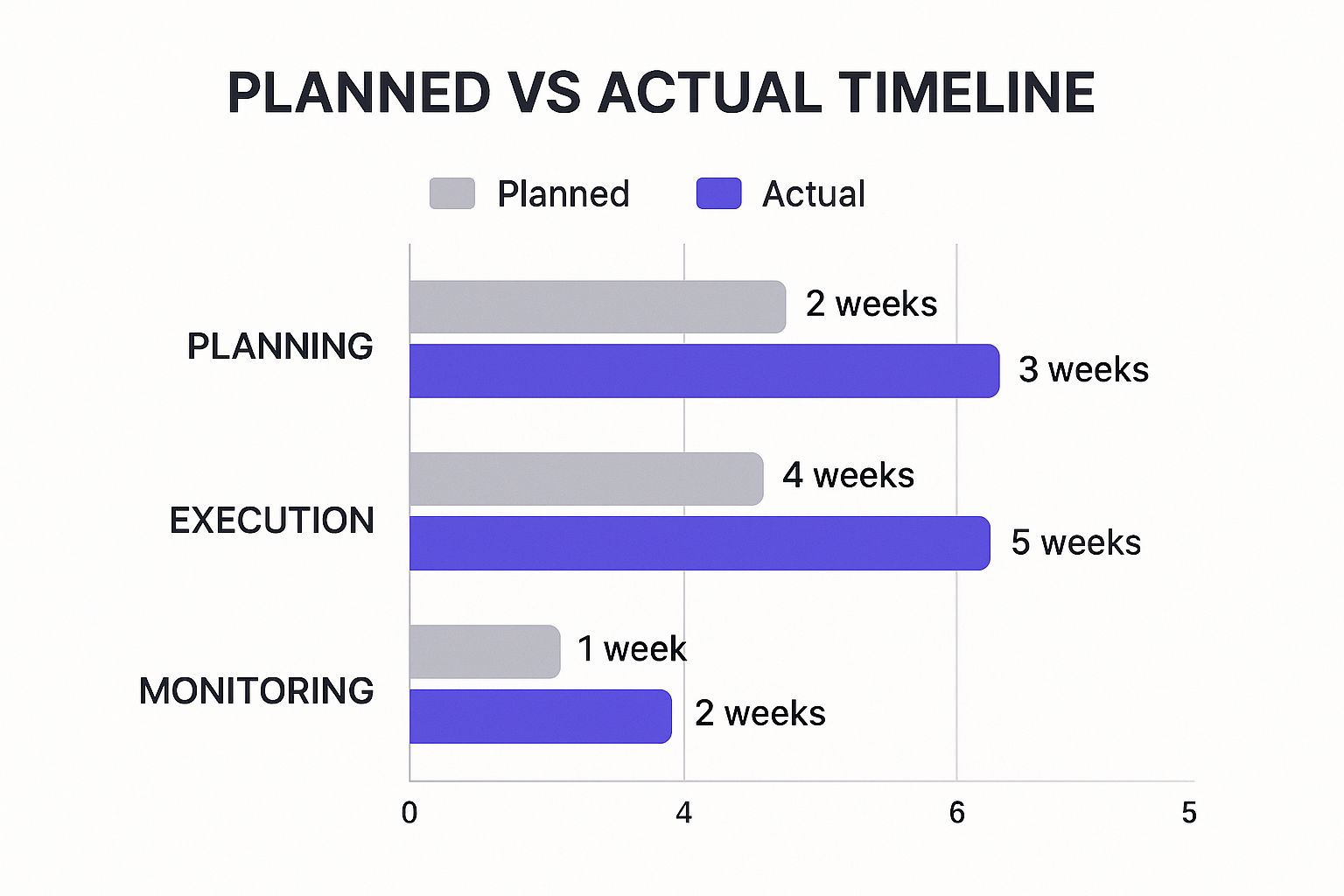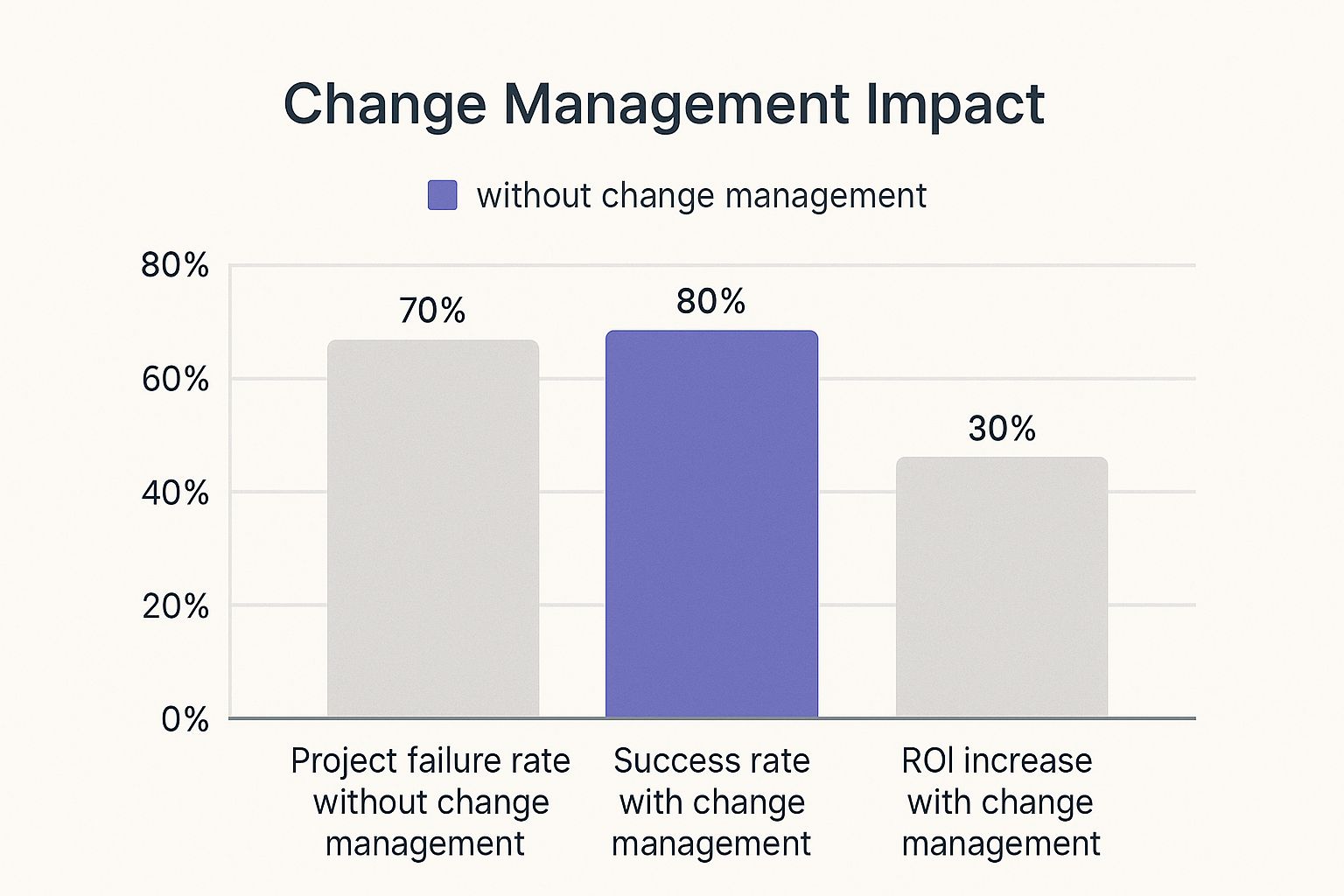Every leader has a brilliant strategy filed away somewhere, but how many see it translate into meaningful results? A strategy is only as good as its execution. This is where the real work begins.
So, what is strategic implementation? In simple terms, it's the disciplined, people-powered process that turns ambitious plans into concrete reality.
Translating Your Vision Into Action

Think of strategic implementation as the bridge connecting the ‘what’ of your strategy to the ‘who’ and ‘how’ of daily operations. It is the structured process of converting big-picture goals into tangible actions, ensuring your vision doesn't just gather dust on a server.
Many organisations excel at crafting impressive strategic plans. But they often stumble at the follow-through. This disconnect happens because implementation is seen as a simple hand-off, not the dynamic, integrated phase it truly is.
Shifting from planning to doing
At its core, strategic implementation is about mobilising your entire organisation—your people, your processes, and your resources—towards a shared set of goals. It's less about abstract thinking and more about tangible outputs and behavioural change.
To understand how this works on a larger scale, it’s useful to explore a guide on building a Digital Transformation Roadmap.
This jump from planning to doing demands a fundamental shift in mindset. Let's compare the two.
Strategy formulation vs strategic implementation at a glance
While closely related, creating a strategy and implementing it are two distinct disciplines. The table below breaks down the key differences.
Understanding this distinction is the first step. Recognising that implementation requires a different set of skills and a hands-on, operational focus is crucial for any leader.
At its heart, strategic implementation answers a simple question: “What are we going to do on Monday morning to make our vision a reality?”. It grounds ambition in the practicalities of day-to-day work.
Effective implementation isn't about rigidly following a script. It’s an adaptive process that demands constant communication, clear ownership, and the right rhythm to build and maintain momentum.
The key activities of implementation
So, what does this process look like on the ground? It boils down to a few core activities that transform a plan from paper to practice.
Successful implementation relies on these pillars:
- Aligning teams. Ensuring every person understands the strategy and how their role contributes. This creates clarity and a shared sense of purpose.
- Allocating resources. Smartly directing budget, time, and talent towards the highest-priority initiatives that will drive the strategy forward.
- Creating actionable workflows. Breaking down broad objectives into clear, manageable tasks and processes that teams can own.
- Establishing clear metrics. Defining how success will be measured and tracked. This keeps everyone accountable and helps maintain momentum.
Ultimately, strategic implementation delivers tangible outcomes. It's the active, ongoing effort that breathes life into a strategic plan, enabling your organisation to build its future.
The Three Pillars Of Successful Implementation
Successful strategic implementation is a structured discipline built on three pillars: People, Process, and Technology. When these elements are aligned, a strategy moves from a document to a living part of your organisation's DNA.
At Yopla, we always lead with people. True transformation starts with people, not platforms. You can have the most elegant plan in the world, but it will fall flat without the commitment of the people expected to execute it. Only then can you design the processes that guide their work and select the technology that supports them both.
Let’s break down each pillar.
People: The heart of the operation
Your people are the engine of your strategy. True implementation success is achieved when your teams move from passive compliance to active ownership of the goals.
This begins with clarity. Does everyone, from leadership to the front line, understand not just what they need to do, but why it matters? Effective communication is an ongoing dialogue that translates high-level objectives into meaningful context for each role.
Achieving this requires:
- Genuine buy-in. Moving beyond mere agreement to a state where teams are invested in the outcomes. This often means co-creating parts of the implementation plan with them.
- A culture of ownership. Empowering teams with the autonomy to make decisions related to their work. When people feel trusted, they take more responsibility.
- Building capability. Ensuring your teams have the skills and confidence needed to perform their new roles. This builds lasting digital sovereignty inside your organisation.
Process: The blueprint for action
Once your people are aligned, you need a blueprint for action. A well-designed process converts strategic objectives into concrete, repeatable workflows. It’s about creating structure without introducing stifling bureaucracy.
This pillar defines who does what, by when, and how progress is tracked. Without clear processes, even the most motivated teams can end up working in circles, duplicating effort, and becoming frustrated.
We see process as the guardrails for strategy. It keeps everyone moving in the same direction, preventing talented people from veering off into well-intentioned but unproductive detours.
Effective processes are critical for accountability and visibility. They ensure everyone knows what success looks like and how their work contributes to it. In complex initiatives, clear processes are also vital for successful strategic partnership management, ensuring all parties are aligned.
Technology: The enabler of progress
Technology is the final pillar, and its role is to serve the first two. The right tools should simplify complexity, not add to it. Technology acts as a powerful enabler, automating repetitive tasks and providing data for better decision-making.
A strong public sector example can be seen in national security. The UK's Strategic Defence Review 2025 involves implementing all 62 recommendations to modernise defence, supported by a £15 billion investment. This plan integrates people (projecting over 9,000 jobs), process (phased commitments), and technology (integrating AI and drones). You can find more detail on the government's official review page.
When selected correctly, technology should:
- Simplify communication. Create a single source of truth, like our Plans Portal, where progress is visible to everyone.
- Automate workflows. Free your team’s time from low-value tasks so they can focus on strategic activities.
- Provide actionable insights. Surface the right data to help you track performance and make smarter, faster decisions.
When people, process, and technology are integrated, you create a system that drives your strategy forward with clarity and purpose.
Frameworks For Structuring Your Implementation
While every organisation is unique, you don’t need to invent an implementation process from scratch. Proven frameworks provide a structured foundation for your efforts, helping to organise thinking and align teams.
The key is to see them as toolkits, not rigid rulebooks. A common pitfall is becoming more fixated on perfecting a framework than on achieving the strategic goal. The framework should serve the strategy, not the other way around. It’s about choosing and adapting a model that fits your team, goals, and operational rhythm.
The Balanced Scorecard (BSC)
The Balanced Scorecard is a classic for a reason. It helps translate a high-level vision into a comprehensive set of performance measures. Its power lies in pulling you away from looking only at financial metrics to give you a more holistic view of organisational health.
The BSC encourages you to look at performance from four perspectives:
- Financial. How do we look to our shareholders? This covers traditional metrics like revenue growth.
- Customer. How do our customers see us? This is about satisfaction, loyalty, and market share.
- Internal business processes. What must we excel at? This examines operational efficiency and quality control.
- Learning and growth. How can we continue to improve? This covers employee skills, culture, and tech capabilities.
By balancing these four areas, you get a clearer picture of cause and effect. It helps you see how improvements in one area, like employee training, link to outcomes in others, like happier customers and stronger financial results.
Objectives and Key Results (OKRs)
If you're after a more agile approach, Objectives and Key Results (OKRs) offer a brilliant alternative. This framework is fantastic for setting ambitious goals and tracking progress through concrete, measurable outcomes.
An Objective is a memorable, qualitative description of what you want to achieve. It should be aspirational.
Key Results are specific, measurable metrics—usually two to five per objective—that show you're on your way. If you hit your Key Results, you deliver on your Objective.
OKRs force a shift in focus from output (the tasks we complete) to outcomes (the results we achieve). This change in perspective empowers teams to find the best way to hit their targets, fostering innovation and accountability.
This framework is also highly transparent. It cascades from the company level to individual teams, ensuring everyone understands how their work contributes to the bigger picture.
Hoshin Kanri
Originating from Japan, Hoshin Kanri is laser-focused on ensuring strategic goals are consistently communicated and acted upon. The name roughly translates to "compass management," which captures its purpose of giving everyone a reliable direction.
The core of Hoshin Kanri is "catchball." Strategic objectives are passed from senior leadership to middle management, who discuss and refine them with their teams before passing them back up. This dialogue ensures that goals are realistic, understood, and have buy-in at every level. It aligns daily improvement activities with the company's overarching vision.
For a modern example of a strategic framework, explore the principles behind the Product-Led Growth (PLG) framework.
Choosing your implementation framework
So, which one is right for you? It depends on your goals and company culture. There’s no single "best" answer, only the best fit for your situation.
Here’s a quick comparison of the three frameworks.
The best framework is the one your teams will actually use. Think of these as starting points. Feel free to borrow elements from each and create a hybrid model that works for your context. The goal is progress, not perfection.
The chart below shows how even well-laid plans can run into delays, highlighting why you need to monitor progress closely.

The data shows that each phase of implementation took longer than planned. This is a common scenario, and it’s precisely why agile frameworks and regular progress reviews are critical for keeping a strategy on track.
Why So Many Strategic Plans Fail To Launch

Understanding why so many strategies fail at the first hurdle is just as important as knowing how to build one. In our experience, the reasons are almost always rooted in avoidable blockers that appear after the strategy is signed off.
These aren't complex theories. They are the candid, real-world issues we see derailing good intentions every day. By confronting these common failure points head-on, you can spot and address them early.
The disconnect between vision and reality
The most common failure point is a chasm between the boardroom's vision and operational reality. This disconnect creates confusion and inertia.
- Poor communication. The strategy is announced, but never translated for the teams doing the work. People are left confused about what it means for their day-to-day.
- A strategy without a budget. Ambitious goals are set, but no one allocates the resources. Without time, money, or people, the plan is dead on arrival.
- Lack of clear ownership. When everyone is responsible, no one is. If roles and responsibilities aren't explicitly defined, accountability evaporates.
We often find that a strategy's success is determined not by its brilliance, but by its clarity at every level. If the people doing the work don't understand their part, the plan remains a document, not a mission.
Human resistance and organisational inertia
Even with a clear plan, you cannot ignore the human element. Resistance to change is natural. It often comes from a fear of the unknown, a perceived loss of status, or the comfort of old routines.
This inertia is a silent killer of strategic momentum. It’s that "we've always done it this way" mindset that quietly suffocates new initiatives. Overcoming it takes more than a top-down mandate. It demands empathy, clear communication about the "why," and unwavering support from leadership. This is a common theme in discussions about why so many digital transformations fail, and the lessons apply here.
The danger of an inflexible plan
Finally, many strategic plans fail because they are too rigid. The world doesn't pause while you execute your three-year plan. Market conditions shift, new competitors emerge, and unexpected challenges arise. A plan that cannot adapt is a plan destined to become irrelevant.
This need for adaptive implementation is critical even at a national level. For example, when the UK’s Office for National Statistics faced data quality challenges, it launched a £10 million plan to enhance economic statistics. This implementation involves recruiting 150 skilled professionals and adapting methodologies to restore trust, showing how even large public bodies must be agile. You can explore more about this plan for economic statistics transformation.
Your implementation process must have feedback loops built in. Regular progress reviews are not about assigning blame. They are about learning and adjusting course. This creates a resilient strategy that can bend without breaking, turning roadblocks into opportunities to refine your approach.
Guiding Principles For Effective Implementation
Turning theory into results takes more than a good plan. It calls for guiding principles that steer your organisation through strategic change. We believe a strategy must be a living part of your operations, not a static document filed away and forgotten.
Effective implementation isn't about rigid, top-down control. It’s about creating an environment where your teams are set up to succeed. This means establishing clear metrics, nurturing a culture where people feel empowered, and building solid feedback loops to keep everything on track.
Make the strategy actionable
First, the strategy has to feel real for everyone involved. A visionary statement on a slide deck won’t cut it. It needs to be broken down into tangible actions and objectives that people can see and act on.
This is about translating high-level goals into specific, measurable milestones for each team. When people understand how their contributions connect to the bigger picture, they shift from complying to taking active ownership. That clarity is the bedrock of any successful strategic implementation.
A core principle is the continuous cycle of learning and adapting. This involves actively analyzing customer feedback to guide your next steps. This ensures the strategy stays grounded in reality and responsive to what your customers need.
Foster a culture of ownership
Real change starts with people, not platforms. A classic mistake is to push a strategy from the top down without getting genuine buy-in. Successful leaders do the opposite: they create a culture of ownership where teams are trusted to solve problems and make decisions.
This is what our copilot approach is about. We don’t just advise from the sidelines. We partner directly with your teams. This hands-on collaboration not only speeds things up but, more importantly, builds lasting skills and confidence inside your organisation. It ensures you truly own the outcome and have the capability to sustain it.
An empowered team is an engaged team. When you give people the autonomy to contribute to the 'how,' they become deeply invested in the 'what.' This shift from delegation to empowerment is what turns a good plan into a great result.
This approach taps into the collective intelligence of your organisation. When data and insights are shared, decisions get sharper, freeing up valuable time and driving impact that lasts. For a deeper look, our guide on digital transformation strategies offers more on building this kind of internal strength.
Maintain momentum and adapt
Let's be candid: no strategic plan survives first contact with reality completely intact. Momentum is everything. You maintain it by celebrating small wins and adapting quickly to new information. Don't wait for the annual review to find out what’s working. Instead, set up regular, short-cycle check-ins to monitor progress and clear roadblocks.
A brilliant public sector example is the Office for National Statistics (ONS). Their 2025-2026 strategic plan includes publishing over 800 statistical outputs, a huge undertaking that demands disciplined implementation. The ONS relies on structured governance to oversee risk and track milestones, ensuring they stay accountable. It’s a perfect illustration of how detailed planning and ongoing risk management keep large-scale strategies from going off the rails.
Think of your implementation plan as a roadmap, not a railway track. It should point you toward your destination but give you the flexibility to navigate obstacles and seize opportunities along the way.
Your Next Steps Toward Seamless Implementation
We’ve talked through what strategic implementation is and the common traps to avoid. But knowledge is only half the battle. Now it’s time to shift from knowing to doing.
The good news? This journey doesn’t start with a massive, disruptive overhaul. It starts with an honest look at where you are right now.
Real change always starts with people and clarity. Before you think about new software or processes, you must understand the human element of your organisation. A strategy that isn't embraced by the people who have to bring it to life is just a document gathering dust. Your first move is to cut through the noise and ask the right questions.
An initial checklist for your team
Get your leadership team in a room for a candid conversation around these points. The goal isn't to point fingers, but to uncover misalignments and shine a light on where your focus needs to be.
- Shared understanding. Does everyone really get the strategy? Could someone on the front line tell you how their daily tasks connect to the big picture?.
- Clear metrics. Do we have a simple, agreed-upon way to measure progress? Do we all know what success looks like in three, six, and twelve months?.
- Resource alignment. Take a hard look at your budget. Does it actually back up your strategic priorities, or are you just funding the status quo?.
- Ownership and accountability. Is it crystal clear who owns each piece of the puzzle? If a key initiative stalls, do we know who is responsible for getting it moving?.
Answering these questions honestly is often the toughest part of the process. It means facing uncomfortable truths. But this kind of clarity is the bedrock of any meaningful change.
This initial check-in isn’t about finding fault. It’s about building the collective intelligence you need to make sharper decisions. By asking these simple questions, you start the vital work of getting everyone aligned and focused on a common purpose.
This is the Yopla way: practical, grounded change that works. We focus on building capability from the inside, ensuring the ownership and control of your strategy stay right where they should be—within your organisation. If you're ready to move from planning to action, let's talk.
Frequently Asked Questions About Strategic Implementation
We've covered a lot of ground. But leaders often have some very practical, "how does this actually work?" questions. Let's tackle a few of the most common ones.
How long should strategic implementation take?
There's no magic number here. The timeline depends entirely on what you're trying to achieve. A small operational tweak might be done in a single quarter. A full business model transformation could easily be a multi-year journey.
The goal isn't breakneck speed. It's sustained momentum. It's far more effective to break your grand strategy into smaller, phased milestones with clear deliverables. This approach lets you secure early wins, celebrate progress, and adjust your plan based on what you're learning.
Who is responsible for strategic implementation?
While the C-suite is accountable for the vision, successful implementation is a team sport. You might have a dedicated programme manager, but you need every department to feel a real sense of ownership.
For any strategy to stick, people need to see how their day-to-day work connects to the bigger picture. When that link is clear, accountability naturally follows. People stop waiting to be told what to do and start taking the initiative.
Strategic implementation isn't a task you can delegate away. It's a group effort. Leadership provides the compass, but it’s the empowered teams on the ground who navigate the terrain. This shared ownership is the secret sauce for creating change that lasts.
How often should we review our implementation plan?
Think of your implementation plan as a living guide, not a dusty file. Its real value comes from being used constantly to make decisions.
To keep things moving, we recommend a steady rhythm of check-ins:
- Monthly for the leadership team. A high-level look at progress against core metrics and a chance to clear strategic roadblocks.
- Weekly or bi-weekly for project teams. These huddles are crucial for tracking tactical work, flagging immediate problems, and making quick adjustments.
And don't forget an annual review. It’s vital for checking if the overall strategy still makes sense in light of major market shifts or internal changes.
What's the difference between strategic implementation and change management?
This is an important one to get right. Let's use a house-building analogy.
- Strategic implementation is the architect's blueprint and the construction work. It’s the ‘what’ and the ‘how’ – creating new processes, installing tech, and defining how everything will operate.
- Change management is about helping the family move into their new home. It’s the ‘who’ and the ‘why’. This is the crucial human element—communicating what's happening, managing anxieties, and helping people adapt to the new setup.
You cannot have one without the other. A perfectly built house is useless if the family refuses to move in. Both are absolutely essential for success.











